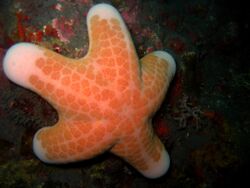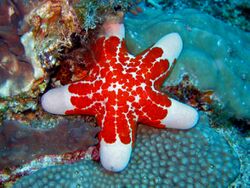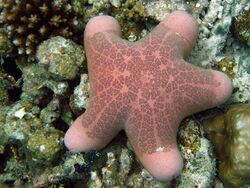Biology:Choriaster granulatus
| Choriaster granulatus | |
|---|---|

| |
| Choriaster granulatus in Occidental Mindoro, Philippines | |
| Scientific classification | |
| Kingdom: | |
| Phylum: | |
| Class: | |
| Order: | |
| Family: | |
| Genus: | Choriaster Lütken, 1869 [1]
|
| Species: | C. granulatus
|
| Binomial name | |
| Choriaster granulatus Lütken, 1869
| |
Choriaster granulatus is the only species in the genus Choriaster, but is most commonly known as the granulated sea star. Other common names include Big-Plated Sea Star and Doughboy Starfish.[2] This species is harmless to humans.
Description
Choriaster granulatus is a large sea star with a convex body and five short arms. The maximum growth radius is about 27 cm. It is a pale pink color with brown papillae in the center.[3]
Location
This species is found in numerous tropical waters, including:[4]
- East Africa[5]
- Indo-Pacific region
- Great Barrier Reef
- Red Sea
- Vanuatu
- Fiji
- Papua New Guinea
Habitat

Choriaster granulatus prefers shallow waters, having a depth range of 1.5 - 53m deep. The water temperature is above average, ranging from 24-29 °C.[6] Choriaster granulatus has been found individually or in groups in the Indo-West Pacific region along coral reefs.[7] It has also been found in the Red Sea, Fiji, and Great Barrier Reef.[8] The sandy habitat is characterized by rubble slopes and detritus and they have been found among corals and sponges.[9]

Diet
Choriaster granulatus is a carnivore and has its mouth on the underside of its body, like other sea stars. Their prey is absorbed outside their mouths by forcing out their digestive organs from their stomach.[10] It’s prey include carrion and small invertebrates such as coral polyps.[11]
Life cycle and reproduction
Embryos hatch into planktonic larvae before becoming juveniles with five arms. These juveniles will grow up to be sea stars with stubby arms. The Asteroidea class of organisms use both asexual and sexual means of reproduction.[12]
Threats
References
- ↑ C.L. Mah (2010). "Asteroidea taxon details for Choriaster Lütken, 1869". World Asteroidea Database. http://www.marinespecies.org/asteroidea/aphia.php?p=taxdetails&id=206933. Retrieved June 29, 2011.
- ↑ "The Granulated Sea Star - Whats That Fish!". http://www.whatsthatfish.com/fish/granulated-sea-star/325.
- ↑ "Taxonomic". http://domainsoflife.yolasite.com/Granulated-Sea-Star.php.
- ↑ Marine Fish Picture Gallery - Granulated Seastar picture
- ↑ Choriaster granulatus, granular sea star
- ↑ "Granulated Sea Star - Choriaster granulatus - Details - Encyclopedia of Life" (in en). http://eol.org/pages/2943448/details.
- ↑ "Taxonomic". http://domainsoflife.yolasite.com/Granulated-Sea-Star.php.
- ↑ "Taxonomic". http://domainsoflife.yolasite.com/Granulated-Sea-Star.php.
- ↑ "Choriaster granulatus, granular sea star" (in en). http://www.sealifebase.org/summary/Choriaster-granulatus.html.
- ↑ "The Granulated Sea Star - Whats That Fish!". http://www.whatsthatfish.com/fish/granulated-sea-star/325.
- ↑ "Choriaster granulatus, granular sea star" (in en). http://www.sealifebase.org/summary/Choriaster-granulatus.html.
- ↑ "Choriaster granulatus, granular sea star" (in en). http://www.sealifebase.org/summary/Choriaster-granulatus.html.
External links
Wikidata ☰ Q467196 entry

